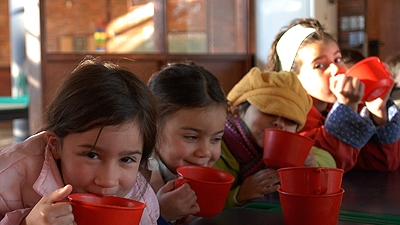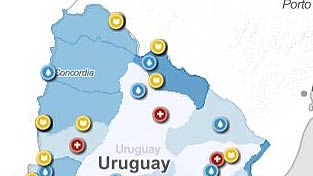Challenge
In 1995, the Uruguayan Government undertook an education reform aimed at improving the equity and quality of education, and increasing access among the poor. The reform recognized the need to improve the quality of education by introducing new pedagogical methods, extending the school day, and improving conditions for the disadvantaged to enter the work force.
Despite improvements, the gap in learning achievements between wealthy and disadvantaged students remained wide. Repetition rates were concentrated in first and second grades and closely correlated to the students’ socioeconomic level. Uruguay’s drop-out rates compared unfavorably with Chile and Argentina. The pace of human capital accumulation, measured by the average number of years of schooling, had slowed, compared to other countries with similar levels of development in the region and Asia.
Solution
The World Bank supported the Government’s education reform and financed the expansion of the Full-Time School Model. Schools operated over extended school hours and offered breakfast, lunch and snacks for students. The Project provided award-winning educational facilities, equipment and learning materials. Teachers and administrators received in-service training.
The Project also supported the focus on socio-economically disadvantaged students through, among other initiatives, the creation of interdisciplinary teams to strengthen school-family partnerships. These were later institutionalized within the Pre-school and Primary Education Council. The Government channeled substantial additional resources to students from the lowest quintiles.
Results
During the third phase of the Project (2002-2012), improvements were seen in a range of education equity, quality, and efficiency indicators relating to students from disadvantaged and very disadvantaged socio-economic backgrounds, parents, and school staff. These include:
- Increased capacity through the infrastructure works (building and schools rehabilitation).
- Increased number of students attending schools: from 21,419 to 40,156.
- Between 1999 and 2012, a significant reduction in repetition rates for the poor (lowest two quintiles) students in the first and second grades in both FTS and Non-FTS schools: - From 23.4% to 18.5% for first grade. - From 17.6% to 9.7% for second grade.
- Considering students in FTS schools alone, the results between 1999 and 2012, repetition rates of poor students in the first and second grades also show a decline: - From 23.3% to 12.8% for first grade. - From 17.1% to and 6.1% for second grade.
- Improved academic results of students from disadvantaged and very disadvantaged contexts (as measured by the percentage of students that perform below a pre-defined satisfactory level of proficiency) in Language: from 48.8% in 1999 to 63.1% in 2012.
Bank Group Contribution
The third phase of the Basic Education Quality Improvement Project was supported by an IBRD loan of US$42 million and an Additional Financing of US$29.9 million, and had a total cost of US$93.4 million, including counterpart funds. This followed two earlier IBRD loans of US$31.5 million and US$28.3 million in support of the program’s first two phases. The World Bank also provided substantial technical assistance and was closely engaged on the ground. Most of the Bank team consisted of region-based staff and consultants with vast experience and strong skills, who collaborated closely with the Government team.
Partners
The Project Coordination Unit actively promoted the close participation of key institutional stakeholders, including the National Administration for Public Education’s Central Steering Council (CODICEN) and the Pre-school and Primary Education Council (CEIP). The Project also benefited from meaningful consultations with principals, teachers, students, and parents. Project architects developed highly personalized designs for the school buildings by actively seeking input and feedback from the school and the broader communities.
Moving Forward
A follow-on operation, Support to Uruguayan Public Schools Project, approved in September 2012, continues to provide support to the Government of Uruguay in the ongoing expansion of the FTS model as a means to enhance equity, quality, and efficiency of pre-school and basic education, particularly among more vulnerable population groups. In addition, this operation provides technical assistance for the institutionalization of teacher in-service training within CEIP.
Beneficiaries
As of December 2012, there were a total of 40,156 students enrolled in 175 FTS schools compared to 21,419 students in 92 FTS schools in 2002. The proportion of FTS students with respect to total urban enrollment in pre-school and primary education almost doubled during the life of the project, from 6.2 to 11.7 percent between 2002 and 2011.
Mercedes Chocho is the School Principal of the FTS School #50, in Vergara City at the Treinta y Tres Department: “This school has been built with participation from pupils, teachers, the development commission and parents. We all have collaborated and wish that this small piece of country that is a Full-Time School will help the school community, especially the students, who are grateful for everything this kind of schools offers them”.


